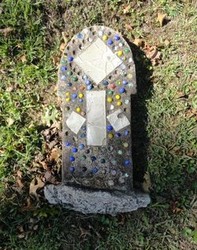Joseph Weekley
Introduction
Text-to-speech Audio
Images
Headstone of Joseph Weekly

Backstory and Context
Text-to-speech Audio
Unfortunately not much is known about the next victim of the Spanish Influenza Pandemic. Joseph Weekly, however, does have one of the more unique headstones of the tour. It has unfortunately suffered significant damage in the past 100 years, however the marbles embedded within the headstone itself are quite beautiful. Joseph is buried next to his brother, Fred, who died when Joseph was only four years old. The year of Fred's death is not known, however the context implies he died young. Joseph himself was quite young, dying at the age of either 15 or 16. The Spanish Influenza was particularly hard on the young due to a condition known as Cytokine Storm. Essentially, the immune system would overreact to the flu, which can weaken the lungs. This made secondary infections - particularly pneumonia - more likely. This overreacting by the immune system is more likely to happen in young individuals, as their immune system has been exposed to fewer illnesses(3). Young Joseph likely suffered from this condition, though we will never truly know for sure. Joseph left this Earth in October of 1918. He was the son of Henry W Weekly and Cora Alice Kelley Weekley and brother to Fred, Charles Edward, Rosella Corra, and Frank Earl.
Sources
- Spreeuwenberg, Peter. Reassessing the Global Mortality Burden of the 1918 Influenza Pandemic. American Journal of Epidemiology, ser. 2561-2567, vol. 187, no. 12. Published September 7th 2018. NCBI.
- Casto, James E.. "Deadly 1918 flu hit Huntington hard." The Herald-Dispatch (Huntington) May 1st 2009.
- Robson, David. Why the flu of 1918 was so deadly, BBC.com. October 30th 2018. Accessed April 28th 2021. https://www.bbc.com/future/article/20181029-why-the-flu-of-1918-was-so-deadly.
https://www.findagrave.com/memorial/65498428/joseph-weekley
